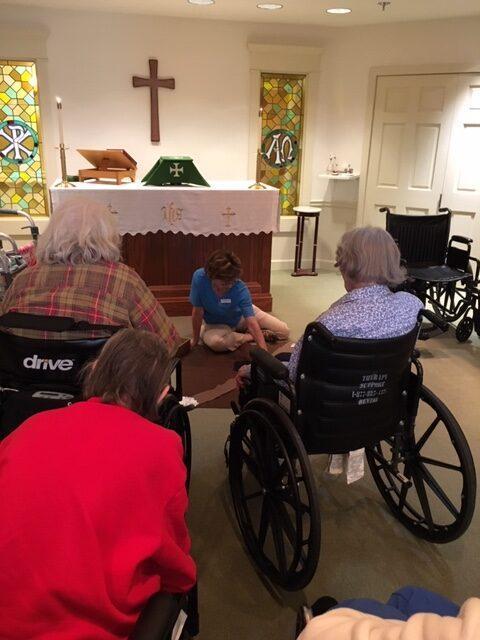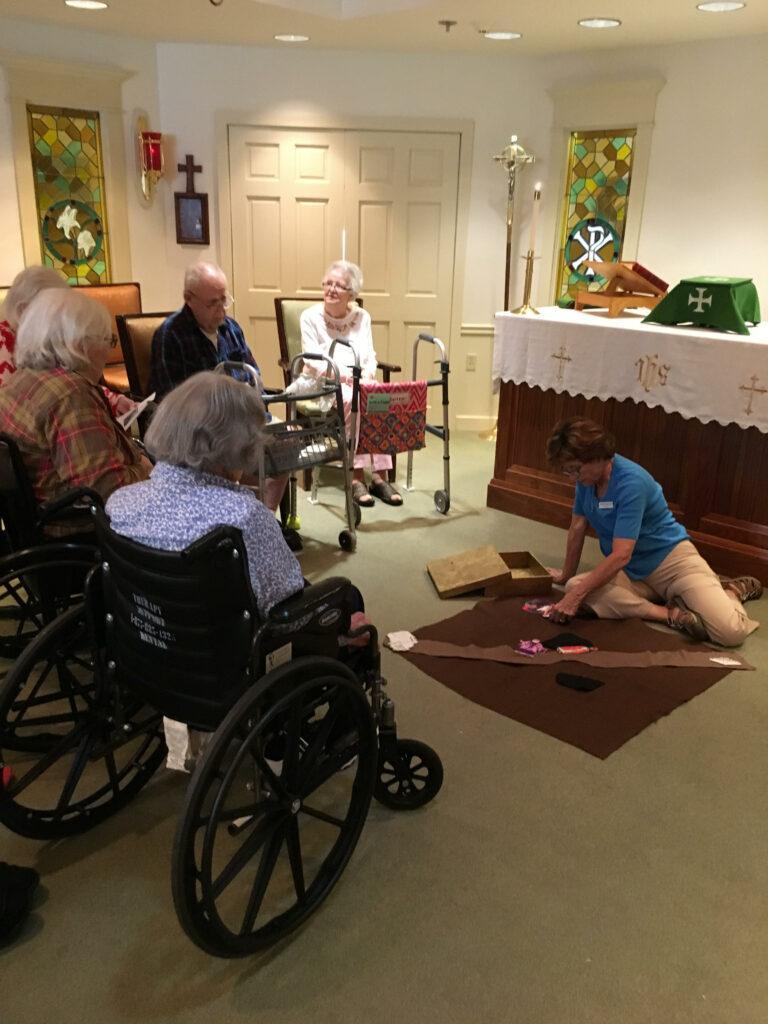Are you using Godly Play in your ministry with older adults? In many ways the people who live in retirement homes or nursing care facilities, people who have lived long, full lives, are not so different from the children we sit in circles with on Sunday mornings. Listen to what Rebecca Nye says in Children’s Spirituality: What It Is and Why It Matters: “Their reality is messy, made up of having a voice and wanting to listen; spiritual intuition and incomprehension of half our words; being people in their own right and dependent on others.” Nye is describing the experience of children; these issues of communication, competence, and independence are struggles that many senior adults cope with as well.
Using Godly Play in A Nursing Care Facility
As a chaplain at a nursing care facility, part of the way that I attend to the spiritual needs of our residents is with Godly Play stories. The facility serves residents who fall along a huge spectrum of ability to care for themselves, to move from place to place unassisted, to feed themselves, to communicate, and to be oriented to time and place. When we form our circle for Godly Play stories each week, the participants may be in wheelchairs; they may have deficits in their ability to see or hear; they may be losing the ability to express themselves the way they want to and struggling with the isolation that brings. Bringing Godly Play to people who are “full of years” is a great gift.
“Godly Play, I discovered, is not only about discovery for these folks, but more often about recovery—remembering events from earlier in their lives,” says Lois Howard in Using Godly Play with Alzheimer’s and Dementia Patients. After hearing the Creation story, one woman, who lives with Parkinson’s Disease and struggles to make herself understood, stopped by the chaplain’s office and said thank you for the story, saying to the chaplain, “The way you tell them helps us to remember.”
Adapting Godly Play for Nursing Care & Retirement Facilities
Show Everyone The Pieces
When I tell stories, some standard storytelling practices for a circle of children are thrown out of the window. Because many in the circle can’t see well, I stand up and walk around to each person to show them the figure of the Good Shepherd or the image on one of the Faces of Easter cards.
Make Eye Contact
I make eye contact periodically while telling the story. Doing so doesn’t “bump them out” of the story the way it might with children. Interruptions happen, usually when someone who grew up in a “know-the-Bible” faith tradition adds a piece of the story they remember that’s not part of the Godly Play script.
Residents Add To The Wondering
When we wonder, I’ll start the wondering questions, and the residents in the circle will wonder as well. “I wonder if Noah thought about and worried about all the people who died in the flood.” Their faith is deep; God is very real. I love the way one woman says “Jesus.” It’s a song full of love.
God Is Deeply Present. Sometimes We Get a Glimpse
Something we’ve probably all experienced with a circle of children or in a youth group setting happens in Godly Play circles with seniors as well: the man in the wheelchair who appeared to be asleep or the woman who took her phone out every few minutes may be the person who offers a profound response to wondering that makes you catch your breath. When we were wondering about why the Good Samaritan stopped to help the man who was by the side of the road, one of the “sleepers” in my circle, said, “Because he knew it was Jesus.”
My wonderful seniors brought tears to my eyes after I finished a story recently. One of them said that once they’ve had a Godly Play story in the Chapel, even when they come back later, they can still feel the story. Amen.
This post contains an affiliate link. When you make a purchase using this link, it supports Virginia Theological Seminary.


